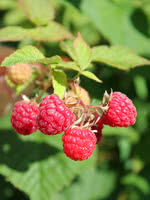Mon-Fri 9am - 5pm Mountain time
Nova Raspberry vs Grouseberry
Vaccinium scoparium
Rubus x Nova
CUSTOM GROW
NOT AVAILABLE THIS SEASON - MIGHT RETURN
Grouseberry is a native, low-growing deciduous shrub known for its edible red berries. In early summer, it produces small, urn-shaped flowers ranging from white to pink that attract bees and other pollinators. The berries provide an important food source for many types of wildlife, including game birds such as grouse, which gives the plant its common name. People can also enjoy the berries fresh or in baked goods, though they can be difficult to harvest in large quantities.
Spreading by rhizomes, Grouseberry forms dense, broom-like mats that help stabilize soil and prevent erosion, while also providing cover for ground-nesting wildlife. It is commonly found beneath conifers in open forests, subalpine meadows, and occasionally on rocky slopes in mountainous regions. It is well-suited for naturalization, ecological restoration, and soil stabilization projects.
Taste is the reason people buy the Nova Raspberry.
Nova canes have very few spines. As it has a firmer berry, it is commonly planted for commercial plantings where a harvester is used.
The Nova Raspberry gets its name from where it was bred, in Nova Scotia. It was created to survive and thrive in the varying climates of Canada.
The Nova Raspberry is a fast-growing floricane. This means that raspberries will not grow on canes the year they first grow. The mature canes they do grow on, however, produce more berries than primocane varieties.

